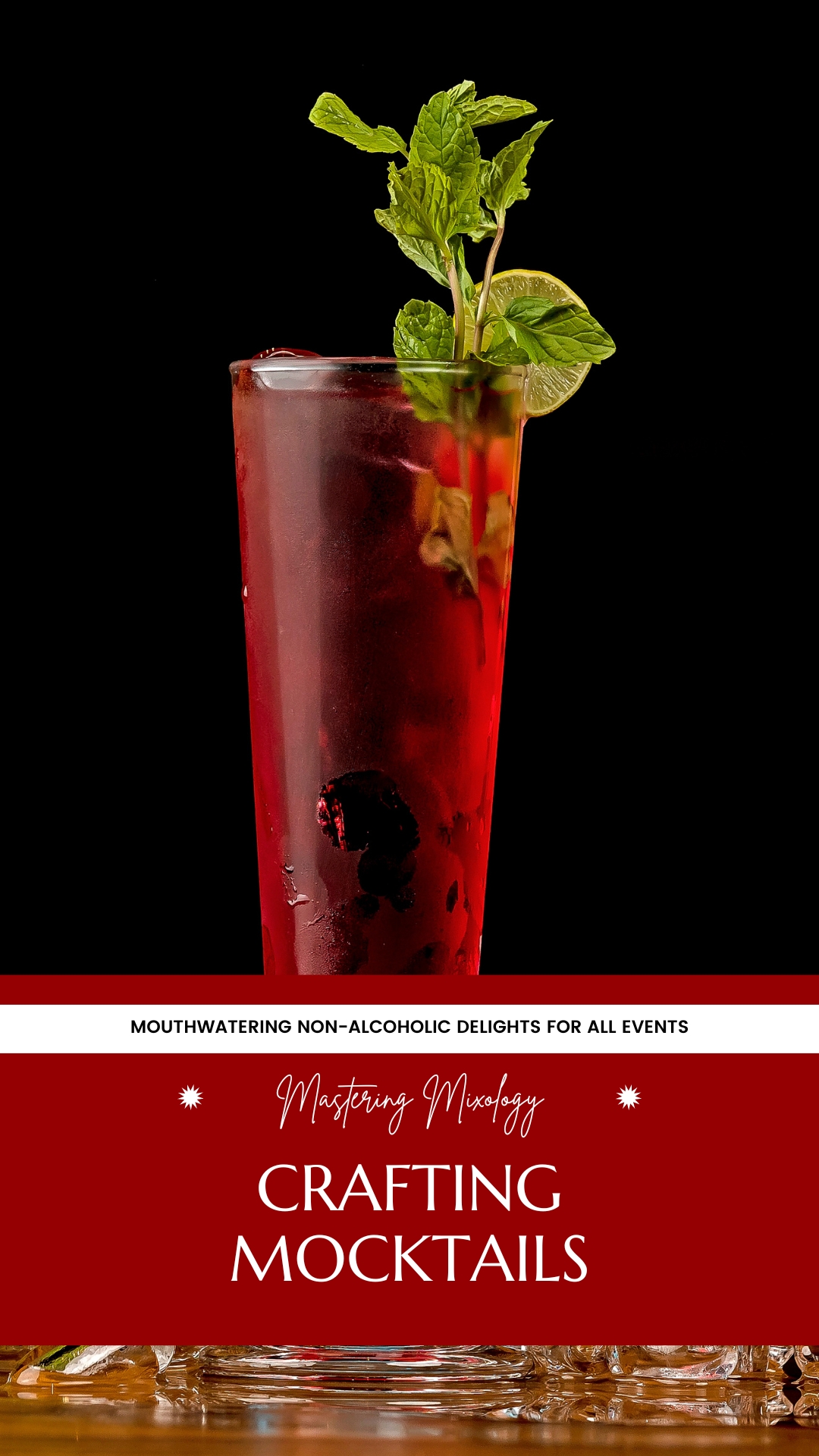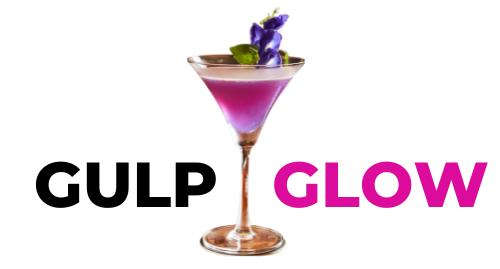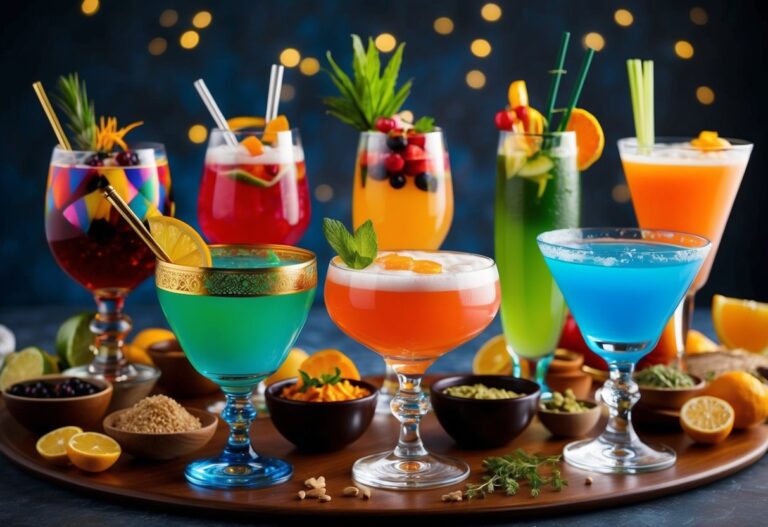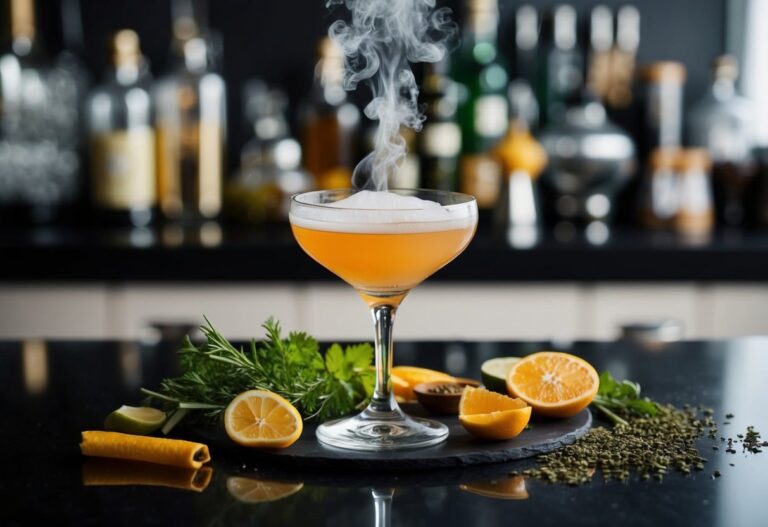Crafting Mocktails: Mouthwatering Non-Alcoholic Delights for All Events
Are you tired of the same old drink options at gatherings? Looking for a tasty alternative that everyone can enjoy? Mocktails are the perfect solution. These creative, non-alcoholic beverages are gaining popularity and for good reason. They’re delicious, fun to make, and suitable for any occasion.
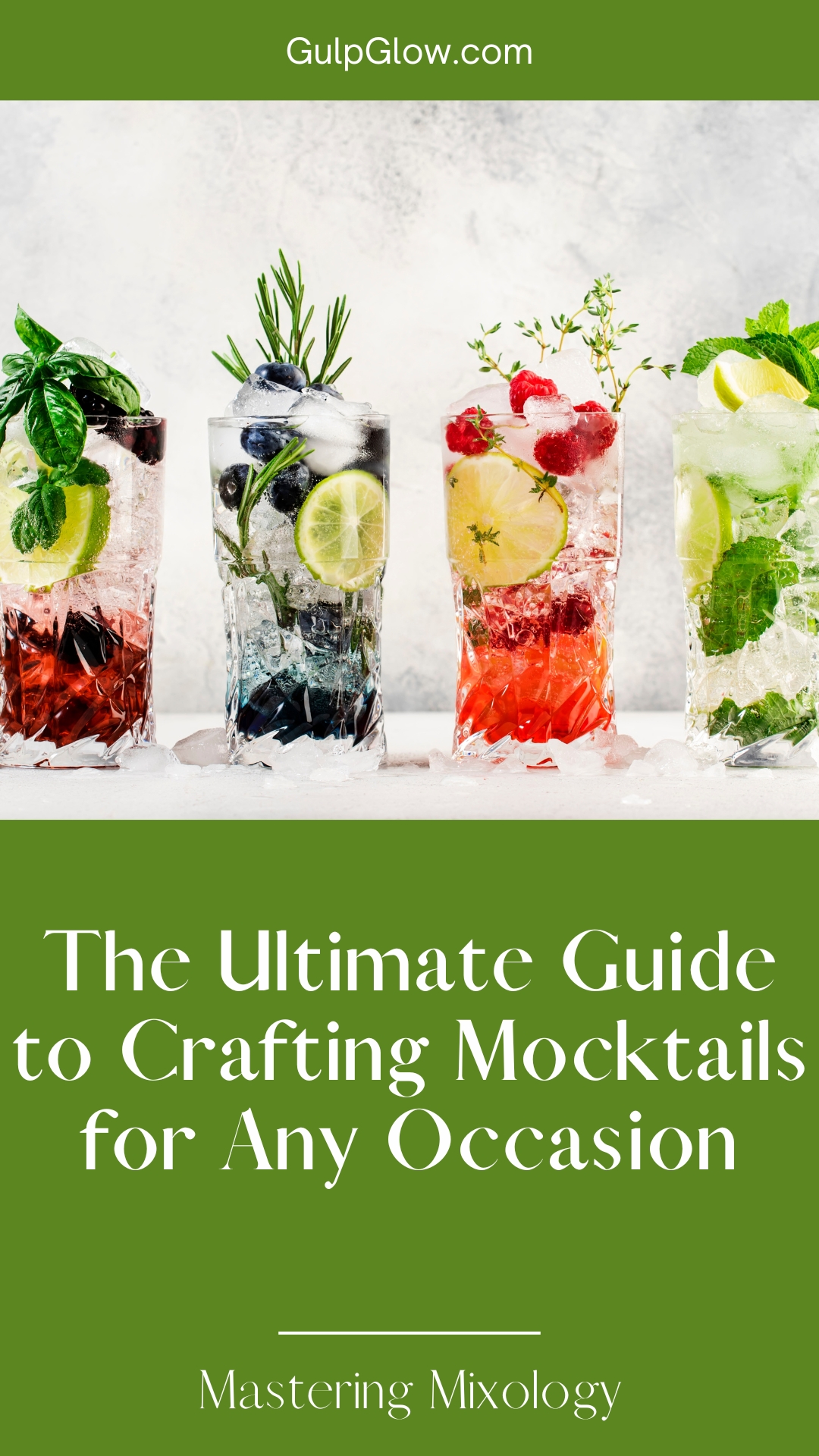
Crafting mocktails allows you to enjoy the flavors and presentation of traditional cocktails without any alcohol. Whether you’re hosting a baby shower, a holiday party, or just a casual get-together, mocktails can be the star of your menu. Use sparkling water, fruit juices, and fresh herbs to create a range of flavorful and refreshing drinks.
Not only are mocktails versatile and easy to customize, but they also offer a healthy alternative to sugary sodas or alcoholic beverages. You can experiment with different ingredients like cranberry juice, ginger ale, and coconut water to add a unique twist to your creations. Dive into the trend and start mixing up your own delightful mocktails today!
The Basics of Mocktails

Making mocktails is a fun and creative way to enjoy delicious drinks without alcohol. You will learn what mocktails are and the benefits of choosing alcohol-free options.
Understanding Mocktails
Mocktails are non-alcoholic beverages that mimic the taste and presentation of cocktails. They use ingredients like juices, sodas, syrups, and herbs. Popular mocktail recipes include the Mocktail Cosmopolitan, which combines cranberry juice, lime juice, and orange extract.
Mint-Basil Limeade is another favorite. It has fresh mint and basil muddled with lime juice and simple syrup, topped with soda water. Mocktails can be as fancy as any cocktail and offer a variety of flavors, from sweet and fruity to spicy and herbal.
Benefits of Going Alcohol-Free
Choosing mocktails offers several health benefits. They provide all the enjoyment of a cocktail without the negative effects of alcohol, such as headaches or dehydration. Mocktails also allow you to enjoy social events without feeling out of place or pressured to drink.
Many mocktails include health-boosting ingredients like fresh fruits and herbs, offering vitamins and antioxidants. Drinks like coconut water and kombucha come with natural electrolytes. They help keep you hydrated and refreshed. Mocktails are a great way to enjoy tasty drinks while supporting your overall health and well-being.
Essential Ingredients and Tools

Crafting delicious mocktails requires a well-stocked pantry and the right tools. This section will guide you on the key ingredients and must-have tools to create flavorful non-alcoholic drinks.
Stocking Your Pantry
To make great mocktails, you need versatile and flavorful ingredients. Here’s a list to get you started:
- Citrus Fruits: Lemon, lime, orange, and grapefruit add a fresh, tangy kick.
- Fresh Herbs: Mint, basil, and rosemary can elevate the taste.
- Sparkling Water and Seltzers: These are perfect for adding fizz.
- Juices: Stock up on classics like orange, cranberry, and pineapple juice.
- Syrups: Simple syrup, grenadine, and fruit syrups bring sweetness.
- Non-Alcoholic Bitters: These can add complexity to your drinks.
Tip: Always keep some fresh fruit and juice on hand to make your mocktails as fresh and vibrant as possible.
Must-Have Tools for Crafting
Creating mocktails is easier with the right tools. Here are the essentials:
- Shaker: A shaker helps mix ingredients thoroughly.
- Jigger: Use this for accurate measurements.
- Strainer: A strainer keeps ice and pulp out of your drink.
- Muddler: Crush fresh herbs and fruits for maximum flavor.
- Long Spoon: This is great for stirring tall glasses.
- Citrus Juicer: Extracting fresh juice is a breeze with a juicer.
For added flair, consider getting garnishing tools like zesters and peelers, which can enhance the visual appeal of your mocktails.
Ready to mix up something refreshing? By having these ingredients and tools at your disposal, you’ll be all set to create a variety of delicious mocktails for any occasion.
Mastering the Art of Balance
Creating the perfect mocktail requires a delicate balance of flavors. It’ll ensure your drink is refreshing, satisfying, and enjoyable.
Flavor Balancing Basics
Harmony is key when mixing mocktails. You want a blend of sweet, sour, bitter, and sometimes salty flavors to keep your taste buds dancing.
You can start by thinking of your ingredients in categories. Sweetness can come from sugar, honey, or simple syrup. Sourness often comes from citrus juices like lemon or lime. Bitterness might come from certain herbs or a splash of tonic water.
Here’s a basic example:
- Sweet: Half an ounce of simple syrup
- Sour: One ounce of lime juice
- Bitter: A dash of tonic water
Combine, taste, and adjust as needed until you hit that perfect balance.
The Role of Sweeteners
Sweeteners are essential in mocktails. They provide the necessary balance against sour or bitter ingredients. Common choices include honey, agave syrup, and sugar.
When using simple syrup, remember it’s just sugar dissolved in water. You can adjust the sweetness by adding more or less syrup.
Honey offers a richer and deeper sweetness. It works well with citrus flavors like lemon juice. Just be sure to dissolve it well so it mixes evenly.
Agave syrup is another good option. It’s sweeter than sugar, so use it sparingly. Plus, it has a subtle flavor that pairs well with most fruits.
Acidity and Bitterness
Acidity brings brightness and liveliness to your mocktail. Most commonly, lemon juice and lime juice are used. They cut through the sweetness and add zing.
For a balanced taste, usually 1/2 to 1 ounce of citrus juice is enough. Always taste and adjust to your liking.
Bitterness can be a bit tricky but is essential for depth. Ingredients like tonic water or certain herbs can add that necessary bitter note. Use them sparingly—a little goes a long way. Try adding just a few dashes, then taste and adjust.
By mastering these elements, you can create delicious and well-balanced mocktails that will impress anyone.
The World of Fruit-Based Mocktails
Fruit-based mocktails are delicious, refreshing, and perfect for any occasion. From zesty citrus flavors to exotic berries and tropical fruits, there’s a mocktail for every palate.
Citrus Delights
Citrus fruits like oranges, lemons, and limes are a favorite in mocktail recipes. They add a zesty, tangy kick that’s both refreshing and invigorating.
One popular option is the classic Virgin Mojito. Made with fresh lime juice, mint, and soda water, it’s a crisp and tasty choice. For something sweeter, try a Cranberry Kiss. Mix fresh orange juice with cranberry juice and top with sparkling water.
For a creative twist, consider a Citrus Sparkler. Combine lemon and orange juice, a touch of honey, and some tonic water. It’s a light and bubbly treat.
Berries and Exotic Fruits
Berries and exotic fruits bring unique flavors and vibrant colors to your mocktails.
Cranberries and blueberries are perfect for cool, fruity drinks. A Blueberry Lemonade combines blueberry puree with lemonade for a sweet-tart refreshment. Or try a Berry Punch with cranberries, blueberries, and a splash of apple juice.
Peaches can be the star of your mocktail. A Peach Fizz blends peach nectar with sparkling water and a hint of lemon juice. This drink is perfect for a summer day.
Mangoes and pomegranates also shine in mocktails. A Mango Tango mixes mango puree with lime juice and soda water. For something cozy, a Mulled Pomegranate-Cherry Juice with spices like star anise and allspice is perfect for cooler days.
Tropical Escapes
Tropical fruits can take your mocktail game to the next level, offering a taste of paradise in a glass.
Pineapple and coconut water create an island vibe. A Pineapple-Coconut Cooler combines pineapple juice, coconut water, and a bit of lime juice for a beachy refreshment.
Watermelon is another fantastic tropical fruit. A Watermelon Slush with pureed watermelon, a dash of lime juice, and mint is both hydrating and delicious.
For a more exotic touch, try a Tropical Peach Mocktail. Mix peach nectar with pineapple juice, a splash of orange juice, and a bit of coconut water. It’s a tropical paradise in every sip.
Whether you’re celebrating or just looking to enjoy a tasty drink, fruit-based mocktails offer something for everyone. They’re easy to make and bursting with flavor, perfect for any occasion.
Herbal and Floral Inspirations

When adding depth and freshness to your mocktails, herbs and flowers can offer unique flavors and aromatic notes. Let’s explore two popular ways to use these ingredients.
Mint and Basil Creations
Mint and basil bring an easy burst of freshness to any drink. Mint has a cool, refreshing flavor while basil adds a slightly peppery and sweet note. Both work well together or on their own.
- Classic Mint Mojito: Mix mint leaves with lime juice and a splash of soda water. Add some sugar if you like it sweet.
- Basil Lemonade: Basil pairs well with the sharpness of lemons. Combine fresh basil leaves with lemon juice and a touch of honey.
- Mint Basil Spritz: For something extra fancy, mix mint and basil leaves with sparkling water and a hint of agave syrup.
Try muddling the herbs to release their aromatic oils, which enhances the drink’s flavor. Whether you’re using mint for its crispness or basil for its complex profile, these herbs can turn any mocktail into a refreshing treat.
Tea Infusions and Floral Twists
For a sophisticated touch, consider using tea and edible flowers. These ingredients can add unique layers of flavor and a beautiful visual element.
- Lavender Earl Grey: Use lavender flowers and brew them with Earl Grey tea. Add some honey for sweetness.
- Chamomile Citrus: Combine chamomile tea with citrus fruits like oranges or lemons. It’s both soothing and tangy.
- Hibiscus Rose Punch: Mix hibiscus tea with rose petals, a sweetener like agave, and some lime juice for zest.
You can also freeze flower petals in ice cubes for a stunning garnish. Both tea and flowers contribute not just to the taste but also to the overall look and feel of your mocktails, making them perfect for any occasion.
Fizz and Texture in Mocktails

Creating mocktails with the perfect fizz and texture can transform an ordinary drink into an extraordinary experience. It’s all about using the right methods and ingredients to bring out those delightful bubbles and mouthfeel.
Soda and Sparkling Water Techniques
When making mocktails, fizz is key. Club soda, sparkling water, and ginger ale are great for adding that fizzy kick. You can also try kombucha for a unique bubbly base that adds a touch of tartness.
For extra bubbles, think about the temperature. Cold liquids hold more fizz, so always chill your soda or sparkling water. Mixing gently helps, too—pour the fizzy ingredient last to keep the bubbles intact.
In some recipes, layering can create an even fancier presentation. Pouring soda slowly over ice helps keep the layers distinct and bubbly. Using flavored sparkling water gives you a quick burst of taste without adding extra sugar.
Crafting Texture
Texture in mocktails brings a delightful tactile sensation. Adding juice ice cubes can give your drinks a pop of flavor and a fun twist. Puree fruits like watermelon or mango for a thicker, more satisfying texture.
Mint leaves, cucumber slices, and fruit chunks aren’t just for show—they add a fresh, tactile element to your drink. Shaking your ingredients well before serving can also create a frothy texture that’s both pleasing to the eye and the palate.
For a creamy finish, try adding coconut milk or an egg white substitute (like aquafaba). These ingredients create a rich, smooth texture without overpowering the drink.
Seasonal and Occasion-Based Mocktails

Create the perfect mocktail for every occasion and season to delight your taste buds. Discover refreshing summer drinks, cozy winter blends, and special celebratory sips for any gathering.
Summer Refreshments
Summer is all about staying cool, and what better way than with a refreshing mocktail? Think watermelon mint cooler, a mix of blended watermelon, fresh mint leaves, lime juice, and optional honey. Pour it over ice and you’ve got a tropical delight.
Another crowd-pleaser is the Lychee Mojito, combining lychee syrup, lime, and mint. Easy to make and bursting with flavor, it’s a drink your family will love on hot summer days.
For a bit more zing, try a Ginger Beer Mocktail with mint, lime, pineapple juice, and a hint of maple syrup. This blend provides a balance of sweet and sour that’s perfect for a summer day.
Winter Warmers
Winter calls for something a bit cozier. Imagine sipping a hot Apple Cider by the fire. Made with apple juice, cinnamon sticks, and a splash of lemon juice, it warms you up inside and out.
A festive favorite is the Non-Alcoholic Hot Toddy. Combine hot water, honey, lemon juice, and a cinnamon stick for a drink that’s both soothing and seasonal.
For a spicier option, try a Gingerbread Mocktail. Mix ginger beer, molasses, allspice, and a dash of cinnamon. This unique flavor combination is sure to bring holiday cheer to your gatherings.
Celebratory Sips
Whether you’re ringing in the New Year or hosting a milestone party, celebratory mocktails add flair to any festivity. A Non-Alcoholic Whiskey Sour is a sophisticated choice, featuring lemon juice, simple syrup, and aromatic bitters for that classic cocktail taste without the alcohol.
For a bubbly treat, craft a Sparkling Raspberry Lemonade. Mix fresh raspberries, lemon juice, and sparkling water. Serve it in a fancy glass to make the occasion special.
Another great pick is the Virgin Mojito. Lime juice, simple syrup, mint leaves, and soda water combine to create a refreshing and elegant drink that’s perfect for toasting any achievement.
Bring excitement to every season and occasion with these tasty, non-alcoholic mocktails!
Advanced Mocktail-Making Techniques
In this section, we’ll explore how to elevate your mocktail game by focusing on layering flavors and using infusion and extraction methods. These techniques will help you create complex, nuanced non-alcoholic beverages that impress every guest.

Layering Flavors
Layering flavors in mocktails involves building complexity by combining different ingredients in a specific order. This technique helps you achieve a balanced taste profile that evolves with each sip.
Start with basic layers: base, middle, and top. The base often includes a fizzy or creamy element like soda water or coconut milk. The middle layer adds depth with syrups or purees, while the top layer might be a garnish of mint leaves or citrus zest.
Consider using contrasting flavors. For example, pair sweet pineapple juice with spicy ginger syrup or bitter grapefruit juice with sweet basil syrup. Use a long spoon or a bar spoon to carefully add each layer to avoid mixing.
Experiment with temperature and texture. For example, freeze juice into ice cubes to slowly release flavor, or use whipped aquafaba to create a frothy topping.
Think about seasonal elements. Use fresh strawberries in summer or warmed apple cider and cinnamon in winter to add timely twists.
Infusion and Extraction
Infusing mocktails enhances flavor by allowing ingredients to steep and release their essence. It requires patience but rewards you with deeply nuanced profiles.
Begin with simple infusions like flavored waters. Add cucumber slices, berries, or herbs to water and let it sit in the fridge for several hours. The longer it sits, the stronger the flavor.
For more complex infusions, use fruits, spices, or even teas. Combine ingredients like blackberries and rosemary with a simple syrup and let it rest in a cool, dark place for 24-48 hours.
Use the extraction technique to draw vivid flavors from solids. This includes muddling fresh herbs like mint or basil with sugar or pressing juice from citrus fruits. These steps release essential oils and intensify flavor.
Don’t shy away from advanced tools. A cold brew coffee maker can make unique syrup infusions, and a fine sieve or cheesecloth helps strain out solids, leaving a clear, flavorful liquid.
Employ these techniques thoughtfully, and you’ll enrich your mocktails with layers of tastes that tell a vibrant story in every glass.
Presentation and Garnishing

Making a mocktail isn’t just about taste; it’s about how it looks and feels. From the way you present the drink to the tiny details in garnishing, every aspect adds to the experience.
The Visual Appeal of Mocktails
Creating a visually stunning mocktail starts with the right glass. Choose glasses that complement the colors and flavors of your drink. Tall glasses work well for layered drinks, while short, wide glasses are great for fruity spritzers.
Color contrast is key. Use ingredients that pop against the glass. A deep red cranberry juice paired with a lime wedge looks striking.
Layered drinks add visual complexity. Pour ingredients slowly over the back of a spoon to keep them separate.
Straws and stir sticks can add fun and function. Go beyond plain straws with colorful or reusable options. Stir sticks can be both decorative and practical, keeping your drink well-mixed and attractive.
Take a look at this simple table to match glass types with mocktail styles:
| Mocktail Type | Glass Type |
|---|---|
| Fruity Spritzers | Short, wide |
| Layered Drinks | Tall |
| Fizzy Drinks | Flute or Highball |
Garnishes and Final Touches
Garnishes can elevate your mocktail from good to great. Fresh herbs like mint or basil add both aroma and flair.
Fresh fruit slices like oranges, lemons, and limes are classic choices. For something unique, try berries or even cucumber slices.
Edible flowers such as pansies or violets can add an exotic touch. Just make sure they are safe to eat.
Maraschino cherries are a colorful and sweet addition. Place one on top or skewer several on a pick for a playful finish.
Olives aren’t just for martinis. They can add a salty contrast to sweet mocktails, especially those with tomato or vegetable juices.
Remember, the devil is in the details. A small twist of citrus peel or a sprig of rosemary can make your mocktail memorable.
Here’s a quick list of popular garnishes to try:
- Mint leaves
- Lemon or lime slices
- Berries
- Cucumber slices
- Edible flowers
- Maraschino cherries
- Olives
Adding these elements thoughtfully ensures that your mocktails are not just drinks, but delightfully crafted experiences. Enjoy your creative touches!
Creating an Inclusive Beverage Menu
Offering a variety of non-alcoholic drinks ensures that everyone feels included, no matter their preference or dietary needs. Use fresh ingredients and creative presentations to make these alternatives just as enticing as their alcoholic counterparts.
Non-Alcoholic Alternatives for Classic Cocktails
Why should anyone miss out on the fun of a classic cocktail? Try making virgin versions of popular drinks:
- Virgin Bloody Mary: Skip the vodka and focus on the robust flavors of tomato juice, Worcestershire sauce, and spices. Don’t forget the celery stalk!
- Non-Alcoholic Piña Colada: Blend up coconut milk, pineapple juice, and ice for a tropical treat. Top it off with a cherry and a slice of pineapple for that beachy feel.
- Classic Sangria: Mix sparkling apple cider, orange juice, and cranberry juice with sliced fruit and a pinch of cinnamon. Chill for a few hours for the best flavor.
- Mock Margarita: Combine lime juice, a splash of orange juice, and agave syrup. Serve with a salted rim.
- Alcohol-Free Strawberry Daiquiri: Puree strawberries with lime juice and a bit of sugar, then blend with ice. It’s a hit every time!
Using non-alcoholic spirits such as Seedlip or Ritual can make these drinks even more authentic.
Catering to All Guests
It’s important to consider the different preferences and dietary needs of your guests. Offer a selection of non-alcoholic beverages to ensure everyone feels catered to.
- Electrolyte-Rich Choices: Natural options like coconut water or watermelon juice can be refreshing and hydrating.
- Bubbly Bases: Sparkling water, club soda, or ginger ale can add fizz without alcohol.
- Fresh Herbs and Fresh Fruits: Mint, basil, and rosemary can add an aromatic twist, while fruits like blueberries, peaches, or pineapples can enhance flavors.
Make sure to label each drink clearly. Use a simple drink menu or table tents to help guests identify their options quickly. This makes it easy for everyone to find a drink they’ll love.
Exploring the World of Non-Alcoholic Spirits
Non-alcoholic spirits have become a delicious and trendy choice for health-conscious individuals and those who prefer not to drink alcohol. From innovative brands to creative mixologists, this world is filled with flavorful options.
The Rise of Alcohol-Free Spirits
Interest in alcohol-free spirits has surged recently. More people are looking for healthier options without sacrificing the social experience. The market has responded with a variety of choices that don’t compromise on taste.
This trend is driven by several factors:
- Health Awareness: Many seek to avoid alcohol due to health reasons, including reduced calorie intake and avoiding hangovers.
- Inclusivity: Non-alcoholic spirits ensure everyone can participate, even non-drinkers.
- Experimental Mixology: Mixologists are creating complex, flavorful mocktails that rival their alcoholic counterparts.
Innovations and Brands
This industry is rich with innovation. Brands are developing products that mimic traditional spirits but without the alcohol content. Here are a few notable examples:
- Seedlip: One of the pioneers in the field, offers options like Garden 108 and Spice 94.
- Lyre’s: Known for its wide range of non-alcoholic versions of classic spirits such as gin, whiskey, and rum.
- Ritual Zero Proof: Focuses on replicating the flavor of spirits like whiskey and tequila, allowing for versatile mocktail creation.
These innovations have changed the way we think about non-alcoholic beverages, bringing creativity and inclusivity to the forefront of social gatherings.
Frequently Asked Questions
Mocktails are a great choice for those who want a tasty beverage without the alcohol. Here, you’ll find easy recipes, celebration-ready drinks, and the latest trends in mocktail crafting.
What are some easy and delicious non-alcoholic cocktails you can make at home?
You can prepare a simple Mango Mule using mango juice, ginger beer, and lime. For a refreshing option, try a Pineapple Mint Mojito with pineapple juice, mint leaves, soda water, and lime.
Can you list some non-alcoholic drinks that are perfect for celebrations?
For celebrations, consider making a Watermelon Margarita, which includes watermelon juice, lime, and sparkling water. Or, try a non-alcoholic classic like the Craftmix Classic Margarita mix paired with sparkling water.
What are the latest trends in crafting mocktails for 2024?
The newest trends feature exotic fruit flavors and handcrafted syrups. Mocktails like lychee rose spritzers and passion fruit blends are gaining popularity. Unique ingredients such as non-alcoholic spirits and herbal infusions are taking the spotlight.
How can you create a buzz without alcohol in your homemade mocktails?
To create a buzz without alcohol, use sparkling water or soda to add fizz. Fresh herbs and spices like basil, mint, and ginger provide extra flavor. Try layering your ingredients to make the drink visually appealing.
What are some of the most popular mocktails that have emerged recently?
Popular mocktails include the Virgin Piña Colada, made with coconut milk and pineapple juice, and the Sparkling Blackberry Lemonade, which combines blackberry syrup and lemon juice with sparkling water. These drinks are both tasty and visually stunning.
Are there any innovative names trends emerging in the non-alcoholic beverage industry?
Yes, innovative names like “Nojito” for a non-alcoholic mojito and “Fizz-Free” for soda-inspired drinks are becoming popular. Creative branding helps these drinks stand out in the crowded market.
